Transistor: Unreal City
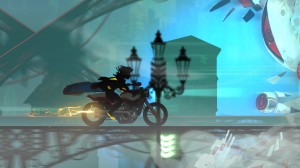 Gene Wolfe famously described good literature as “that which can be read by an educated reader, and reread with increased pleasure.” By that measure, Transistor is a good game: one which can be enjoyed by an experienced player, and replayed with increased pleasure. Not since Chrono Trigger has a game demanded an additional playthrough so forcefully. Even the name, “Recursion Mode,” is a clue. You won’t just be playing the same content a second time. This is a chance to go deeper.
Gene Wolfe famously described good literature as “that which can be read by an educated reader, and reread with increased pleasure.” By that measure, Transistor is a good game: one which can be enjoyed by an experienced player, and replayed with increased pleasure. Not since Chrono Trigger has a game demanded an additional playthrough so forcefully. Even the name, “Recursion Mode,” is a clue. You won’t just be playing the same content a second time. This is a chance to go deeper.
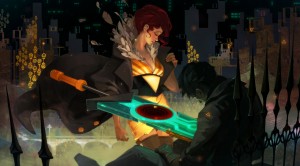 You’ll need it. Transistor is a game that demands a lot from you. Narratively speaking, it doesn’t so much throw you into the deep end as hold you down and see if you’re strong enough to fight back. The game begins with a single striking wordless image, then transitions abruptly into its beautiful and unexplained world. Who is Red, the mute protagonist? What is the Transistor, her talking, pulsating sword? What does Red want, and why is she fighting for it? Where is this shifting, baroque city located? What’s overrun it? Is any of this even real? Transistor expects you to put in work to find your answers.
You’ll need it. Transistor is a game that demands a lot from you. Narratively speaking, it doesn’t so much throw you into the deep end as hold you down and see if you’re strong enough to fight back. The game begins with a single striking wordless image, then transitions abruptly into its beautiful and unexplained world. Who is Red, the mute protagonist? What is the Transistor, her talking, pulsating sword? What does Red want, and why is she fighting for it? Where is this shifting, baroque city located? What’s overrun it? Is any of this even real? Transistor expects you to put in work to find your answers.
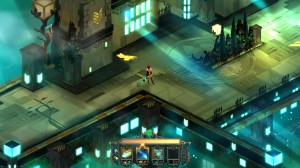 The gameplay, too, is refreshingly oblique, overlaying a surprising strategic element onto an action RPG framework. During combat, you can pause the game and queue up a string of attacks that will be instantly executed when the game is unpaused. After unleashing this concentrated combo, you’re at a temporary disadvantage, unable to fight effectively and only able to dodge incoming attacks. The good news is that real-time combat, as in a traditional action RPG, incurs no such penalty. Ultimately, you’ll find yourself switching between real-time combat, strategic assault, and frantic escape according to the needs of the moment. The game does not explain this, per se. It’s on your shoulders to best exploit its semi-real-time systems through the experimental crucible of combat.
The gameplay, too, is refreshingly oblique, overlaying a surprising strategic element onto an action RPG framework. During combat, you can pause the game and queue up a string of attacks that will be instantly executed when the game is unpaused. After unleashing this concentrated combo, you’re at a temporary disadvantage, unable to fight effectively and only able to dodge incoming attacks. The good news is that real-time combat, as in a traditional action RPG, incurs no such penalty. Ultimately, you’ll find yourself switching between real-time combat, strategic assault, and frantic escape according to the needs of the moment. The game does not explain this, per se. It’s on your shoulders to best exploit its semi-real-time systems through the experimental crucible of combat.
To be clear, the story and gameplay systems aren’t full of holes, just silences. And it’s pleasantly refreshing that the game is patient enough to let you understand its complexity at your own pace and on your own terms. Transistor is well-paced for new players, but never stops for a hand-holding tutorial. It contains charming characters, momentous events, and confident world-building, but at no point does it settle into a comfortable Campbellian monomyth.
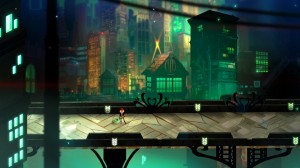 Oh, and it’s drop-dead gorgeous. The city of Cloudbank is an Art Nouveau masterpiece, an isometric wonderland of glass, neon, bold color and patterned geometries. The remarkably assured art direction is more than enough to carry you through your initial patchy understanding. The soundtrack is subdued and moody, like a jazz song you heard once at an underground club and now remember only fuzzily. Red, now mute, was once a singer, and the constantly shifting instrumentation feels like her musical dialogue.
Oh, and it’s drop-dead gorgeous. The city of Cloudbank is an Art Nouveau masterpiece, an isometric wonderland of glass, neon, bold color and patterned geometries. The remarkably assured art direction is more than enough to carry you through your initial patchy understanding. The soundtrack is subdued and moody, like a jazz song you heard once at an underground club and now remember only fuzzily. Red, now mute, was once a singer, and the constantly shifting instrumentation feels like her musical dialogue.
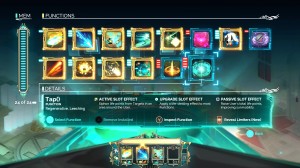 Counterbalancing this lush, romantic design is an almost abrasive level of tech fetishism. Red’s attacks are Functions, with names like Ping() and Crash() and sci-fi chrome to match. Functions are installed into Memory so you can fight your faceless enemy, The Process. Game difficulty is increased by activating Limiters. And so on and so forth, without end. The technical jargon is coherent, consistent, and completely at odds with the appearance of the game world–a dissonance that only reinforces its unique strangeness.
Counterbalancing this lush, romantic design is an almost abrasive level of tech fetishism. Red’s attacks are Functions, with names like Ping() and Crash() and sci-fi chrome to match. Functions are installed into Memory so you can fight your faceless enemy, The Process. Game difficulty is increased by activating Limiters. And so on and so forth, without end. The technical jargon is coherent, consistent, and completely at odds with the appearance of the game world–a dissonance that only reinforces its unique strangeness.
Transistor isn’t a polemic about art vs. technology – it’s about art and technology, in synthesis. Sure, it throws logic, rules, and code into the pit with art, beauty, and humanity, but what emerges is greater than either would be alone. Code and art, in concert, we call a video game.
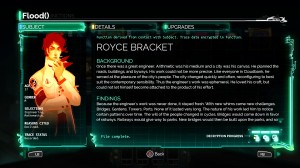 Transistor excels when it embraces the bohemian joie de vivre at its core. Like New Crobuzon, Ashamoil or Virconium, Transitor’s Cloudbank is a volatile city where the powerful upper class and society’s dregs mix uneasily. But as always – in fiction and in life – it’s the dregs who have all the fun. The characters Red meets are a motley bunch: race car drivers, stage magicians, sky-painters, fashion designers. They’re all people who have followed their dream–even if society doesn’t approve–and paid a price–even if they succeeded.
Transistor excels when it embraces the bohemian joie de vivre at its core. Like New Crobuzon, Ashamoil or Virconium, Transitor’s Cloudbank is a volatile city where the powerful upper class and society’s dregs mix uneasily. But as always – in fiction and in life – it’s the dregs who have all the fun. The characters Red meets are a motley bunch: race car drivers, stage magicians, sky-painters, fashion designers. They’re all people who have followed their dream–even if society doesn’t approve–and paid a price–even if they succeeded.
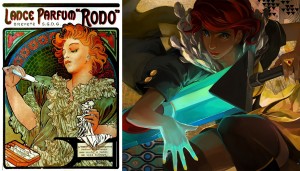 Bohemianism’s origins lie in the uneasy tension between being true to ones artistic ideals and the cruel realities of the modern city. (Its rise is also closely tied to the Art Nouveau and Art Deco movements that so clearly inspired Transistor’s look.) Many bohemians began and ended their brief lives in poverty, but others, despite being born to wealth and privilege, took up the bohemian lifestyle willingly and voluntarily.
Bohemianism’s origins lie in the uneasy tension between being true to ones artistic ideals and the cruel realities of the modern city. (Its rise is also closely tied to the Art Nouveau and Art Deco movements that so clearly inspired Transistor’s look.) Many bohemians began and ended their brief lives in poverty, but others, despite being born to wealth and privilege, took up the bohemian lifestyle willingly and voluntarily.
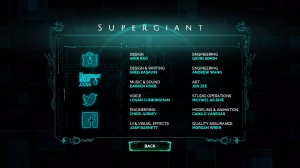 Supergiant Games feels like a group of like-minded voluntary bohemians–people who may have cut their teeth on AAA-gaming, but walked away because they wanted to build something they actually believed in. They’re a small crew whose entire credits page fits on a single page without scrolling. Playing Transistor, it’s still possible to feel where their ambition outpaced their ability or, more likely, their budget.
Supergiant Games feels like a group of like-minded voluntary bohemians–people who may have cut their teeth on AAA-gaming, but walked away because they wanted to build something they actually believed in. They’re a small crew whose entire credits page fits on a single page without scrolling. Playing Transistor, it’s still possible to feel where their ambition outpaced their ability or, more likely, their budget.
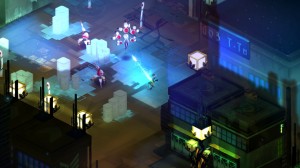 Transistor feels simultaneously short, in its areas and hours, and overstuffed, in the depth of its combat. Red can wield 3,600 possible Active Function combinations, more or less, a number hilariously out of proportion to the actual number of battles. Recursion Mode mitigates this somewhat, providing a place for all this extra gameplay to spill over, but there’s still a clear mismatch between initial design and ultimate implementation.
Transistor feels simultaneously short, in its areas and hours, and overstuffed, in the depth of its combat. Red can wield 3,600 possible Active Function combinations, more or less, a number hilariously out of proportion to the actual number of battles. Recursion Mode mitigates this somewhat, providing a place for all this extra gameplay to spill over, but there’s still a clear mismatch between initial design and ultimate implementation.
Still, it’s a rare game whose flaws are that it says too little and plays too deep. As GIA alum Zak McClendon put it, one of the greatest surprises and pleasures of gaming is “being able to subtly feel the presence of the actual humans who made it.” Transistor is a game made by real people for other people to enjoy. That shouldn’t be unusual, but here we are.
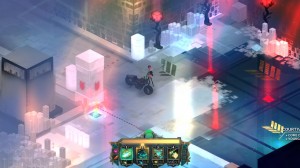 Transistor’s shoulder buttons aren’t mapped to Fire and Grenade, but to two useless, cosmetic interactions: Flourish, which makes Red twirl the Transistor sword dramatically, and Sing, which lets Red sing. At any time, you can ask Red to stop and sing along with the music, no matter the song or circumstance. From one perspective, that sort of development extravagance seems pointless, even wasteful. That a studio the size of Supergiant Games would implement this feature is frankly ridiculous. Even so, Transistor is waiting, and it wants you to sing along.
Transistor’s shoulder buttons aren’t mapped to Fire and Grenade, but to two useless, cosmetic interactions: Flourish, which makes Red twirl the Transistor sword dramatically, and Sing, which lets Red sing. At any time, you can ask Red to stop and sing along with the music, no matter the song or circumstance. From one perspective, that sort of development extravagance seems pointless, even wasteful. That a studio the size of Supergiant Games would implement this feature is frankly ridiculous. Even so, Transistor is waiting, and it wants you to sing along.
One Response to Transistor: Unreal City
Leave a Reply
You must be logged in to post a comment.

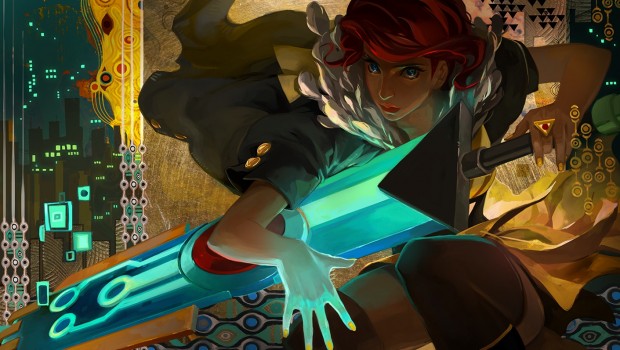

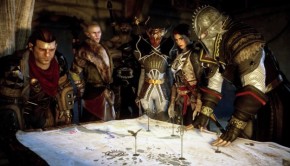







Andrew – Wow, great review! Very clear and insightful. I like the exploration of the Bohemian and Art Deco influences. Those relationships hadn’t occurred to me. Your review actually reminds me quite a lot of the one I just finished writing a few days ago. Different in detail, but similar in spirit. You might be interested to check it out from the standpoint of “Great minds think alike, but fools seldom differ.” I’m going with “great minds” myself. 8^) If you’re curious you can find it here: http://www.eccentric-orbits.com